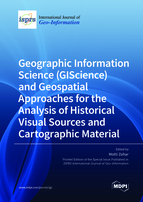Geographic Information Science (GIScience) and Geospatial Approaches for the Analysis of Historical Visual Sources and Cartographic Material
A special issue of ISPRS International Journal of Geo-Information (ISSN 2220-9964).
Deadline for manuscript submissions: closed (31 October 2021) | Viewed by 29611
Special Issue Editor
Interests: GIScience and geoinformatics; cartography and digital mapping; spatial big data analytics; natural hazards; environmental studies
Special Issue Information
Dear Colleagues,
Historical visual sources, such as maps, drawings, sketches, photographs, and aerial photos, contain valuable information for the study of past scenarios. However, while textual sources were intensively used in various historical-based studies, visual sources were analyzed to a much lesser extent. The latest developments of GIScience (geographic information science) and geospatial approaches now offer a wide range of frameworks and methodologies to interpret and analyze historical visual sources. Examples may be found in registering old cartographic material to modern coordinate reference systems (CRS) while verifying quantitatively their accuracy and inclusiveness; creating new forms of virtual knowledge and tracking spatial narratives; performing 2D or 3D landscapes and cityscape reconstructions; establishing deep maps for conveying the everyday life of ancient communities; characterizing temporal and spatial patterns of the human and natural environments; and resolving complex scenarios of past phenomena. These examples and many others demonstrate that the analysis of such sources is of great relevance to many scientific disciplines in the social sciences and humanities but also to disciplines in the natural and life sciences.
In this Special Issue, we cordially invite original research, reviews, and contributions of topics focused on the study of historical visual sources. The submitted manuscripts should demonstrate a sound theoretical novelty achieved by implementing geospatial approaches, or the development of an innovative GIScience-based methodology aimed at the investigation of such sources.
Potential topics involving the study of historical visual sources may include the following:
- Inspecting past temporal and spatial changes of communities or natural phenomena
- Landscape/cityscape reconstructions for the study of the past human environment
- Developing spatial narratives using visual sources
- Developing a unified framework for the analysis of various types of visual sources
- Innovative approaches for quantitative interpretation of cartographic material
- Automation and semi-automation of feature and text extraction from cartographic material
- The integration of GIScience and computer vision machine learning for studying past phenomena
- The scientific challenges in establishing a consistent historical gazetteer.
Keywords
- GIScience
- geospatial approaches
- GIS
- visual sources
- cartography
- historical phenomena






